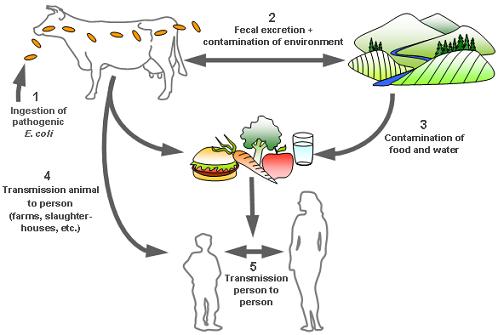This "new version" was E. coli (termed enterohemorrhagic E. coli, or EHEC) was a few extra genes. These new genes encoded bacterial toxins, or proteins that elicit damage to, and death of, human cells. New genes? A bacterial cell can just pick up and find new genes??? Yes, they can. Turns out it's not all that difficult, either. The toxin genes of EHEC came from a type of virus called a bacteriophage. The the "parent" E. coli cell was infected, the virus left behind a few genes, and it turns out, those genes allowed this normally harmless organism to become quite virulent. The more scientists explored this idea, the more it became clear that certain intestinal illnesses could actually be attributed to odd new forms of E. coli, each one producing different toxins. At this point, we have recognized EHEC (sometimes called STEC), EPEC, ETEC, EAEC, EIEC, and STEC [for EnteroPathogenic EC, EnteroToxigenic EC, EnteroAggregative EC, EnteroInvasive EC and Shiga Toxin-producing EC]. They have been circulating in the population causing periodic outbreaks since then, largely due to consumption of contaminated meat or produced exposed as indicated here:
Image from EcL Lab, Universite du Montreal




No comments:
Post a Comment